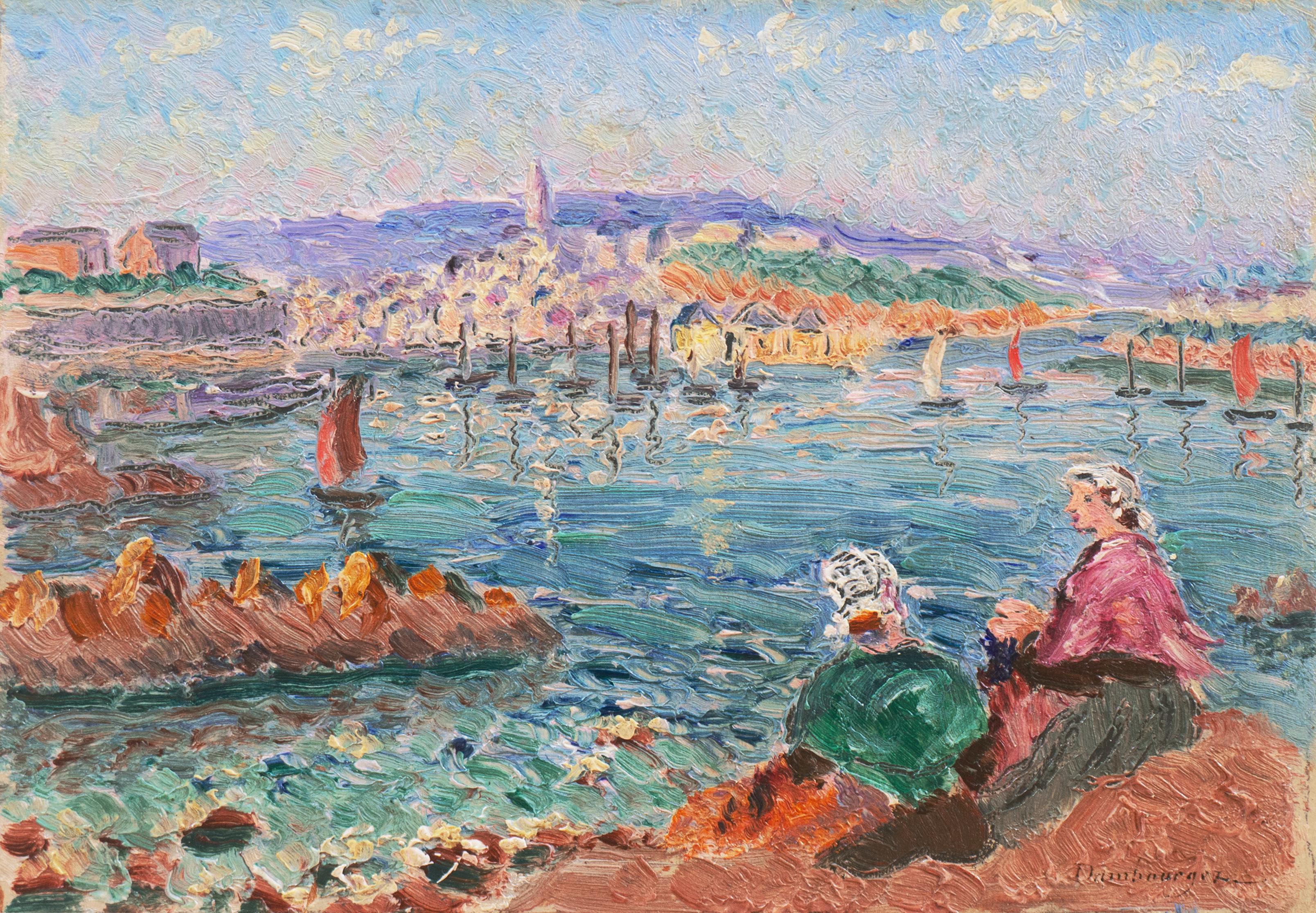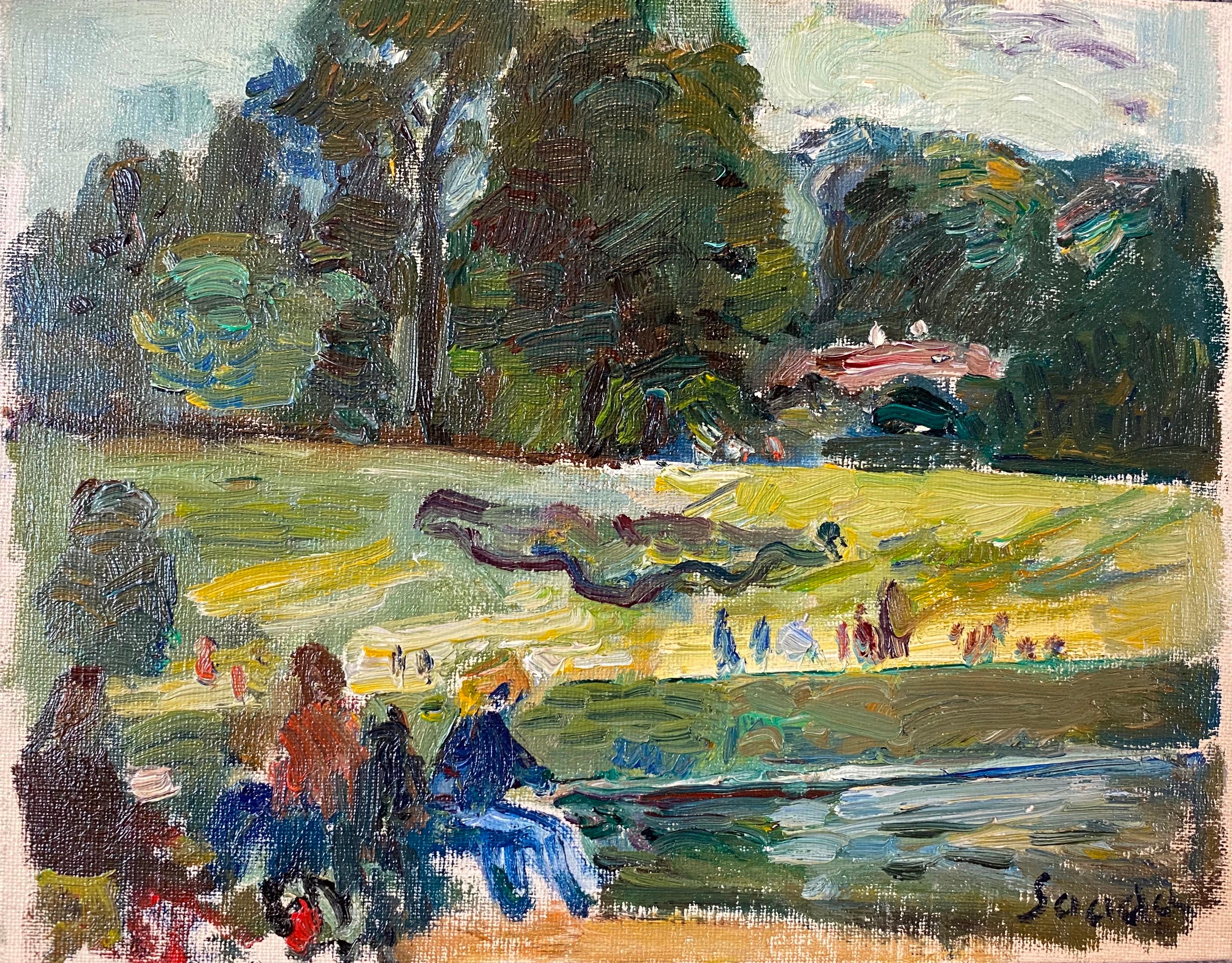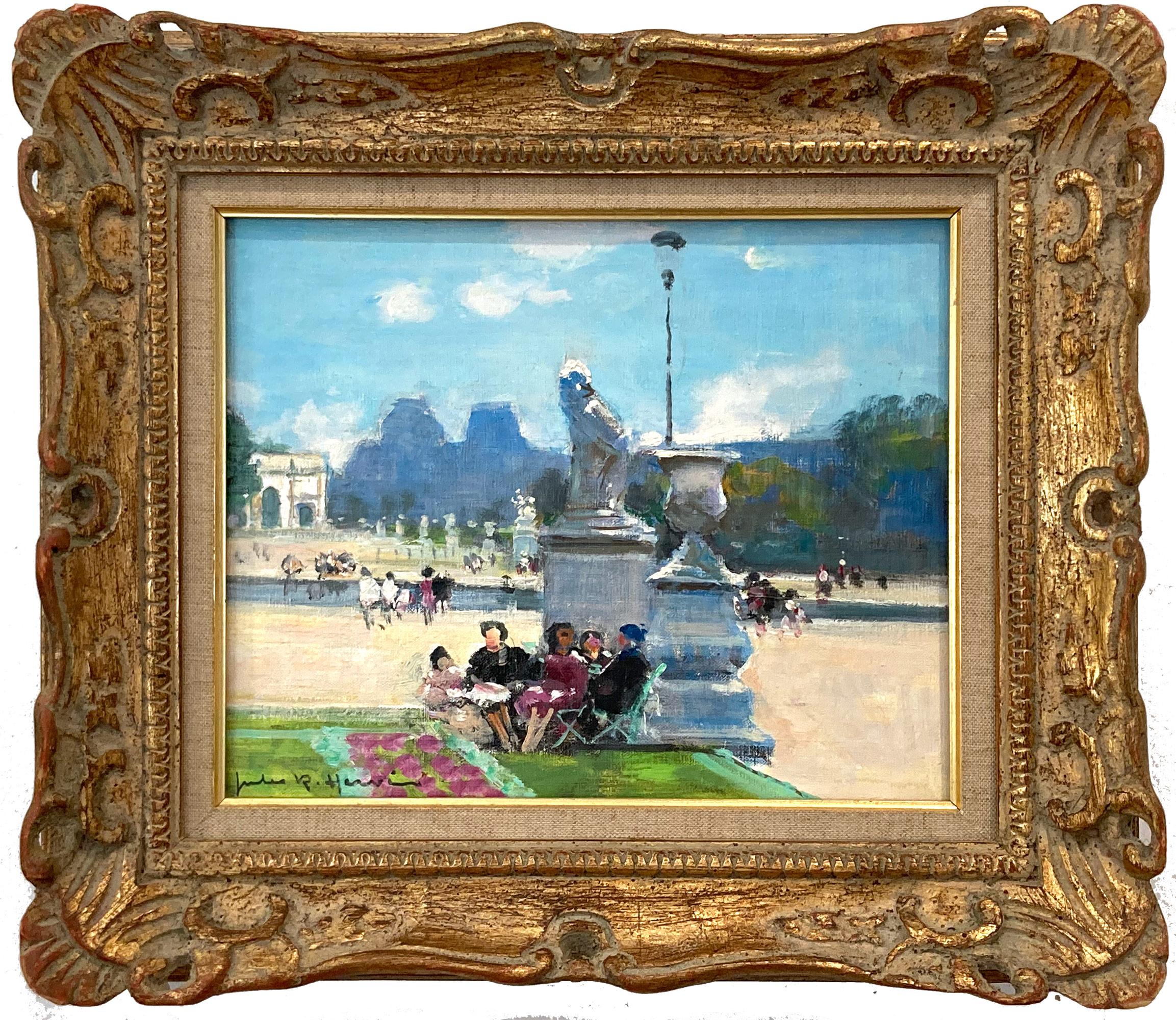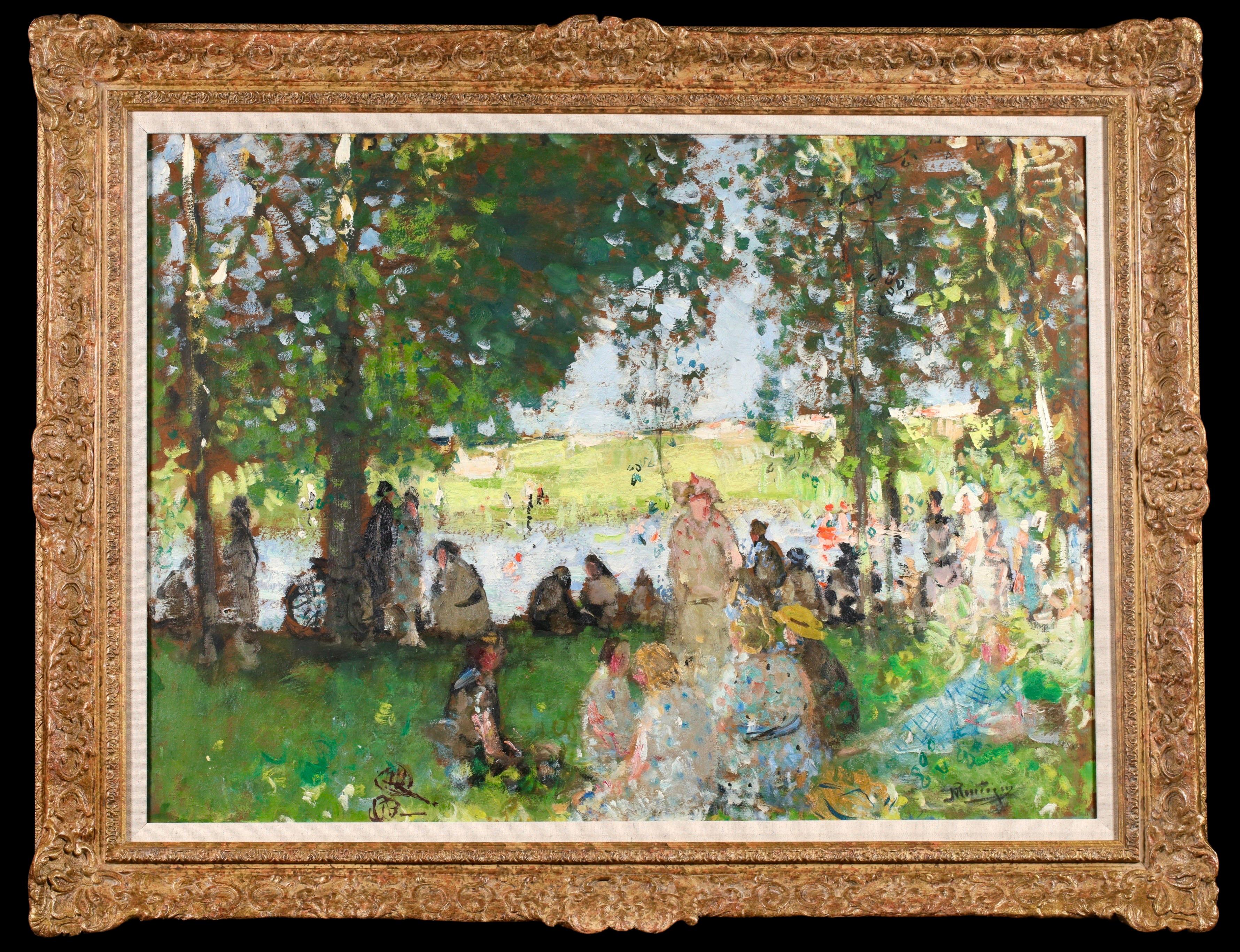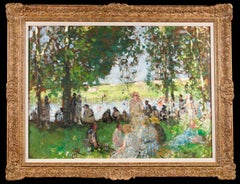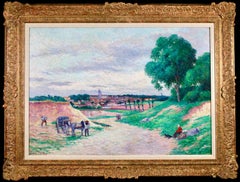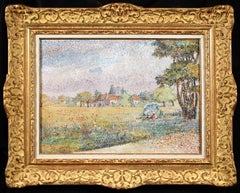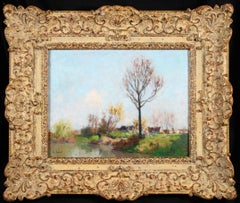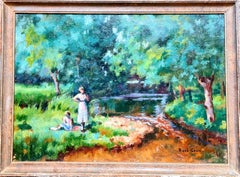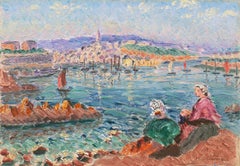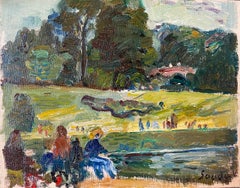Items Similar to Picnic by the Seine - Impressionist Figurative Oil by Albert Dubois-Pillet
Want more images or videos?
Request additional images or videos from the seller
1 of 16
Albert Dubois-PilletPicnic by the Seine - Impressionist Figurative Oil by Albert Dubois-Pilletc.1890
c.1890
Price Upon Request
Price Upon Request
Price Upon Request
Price Upon Request
Price Upon Request
Price Upon Request
Price Upon Request
Price Upon Request
Price Upon Request
Price Upon Request
About the Item
Signed oil on paper laid on board figures in landscape circa 1890 by French Neo-Impressionist painter Albert Dubois-Pillet. This pointillist piece depicts and elegant couple enjoying a picnic on the yellow sand of the bank of the River Seine in Paris, France. They are surrounded by other couples enjoying a day in the sun.
Signature:
Signed lower left
Dimensions:
Framed: 17.5"x21"
Unframed: 9.5"x13"
Provenance:
Private French collection
Albert Dubois-Pillet (28 October 1846 – 18 August 1890) was a French Neo-impressionist painter and a career army officer. He was instrumental in the founding of the Société des Artistes Indépendants, and was one of the first artists to embrace Pointillism.
Louis-Auguste-Albert Dubois was born on 28 October 1846 in Paris. Shortly thereafter, his family moved to Toulouse, where he was raised. In 1867, he graduated from l'Ecole Impériale Militaire in Saint-Cyr and began his career as a military officer. He remained in the army for the rest of his life.
From 1870 to 1871, he served in the Franco-Prussian War, during which the Germans captured him and held him in Westphalia, Prussia as a prisoner of war. After his release, he resumed a post in the Versailles army. Throughout the 1870s he was stationed at several different provincial posts. He received an appointment in 1879 or 1880 to la Légion de la Garde Républicaine (the Republican Guard) in Paris.
Although self-taught, with no formal art education, he proved to be a talented artist. The official Paris Salon accepted one of his still lifes in 1877, and another one in 1879. However, after his arrival in Paris, he created paintings which were somewhat more experimental, and his submissions were rejected by The Salons from 1880 to 1883. Beginning in 1884, he attempted to hide his art-related activities from the military by disguising his name – he added "Pillet", his mother's maiden name, to his name, signing his artworks "Dubois-Pillet".
His painting Enfant Mort (Dead Child), completed in 1881, was displayed at the May 1884 Tuileries Exhibition, where it caught the attention of Émile Zola, who used it as his inspiration for a scene in his 1886 novel L'Œuvre.In the book, artist Claude Lantier, distraught over his son's death, finds himself compelled to create a painting of his dead child.
The Tuileries Exhibition was a one-time event with a goal similar to that of 1863's Salon des Refusés which showed works that had been rejected by the Salon. Dubois-Pillet envisioned a permanent alternative to the official Salon. He met with some of the other exhibitors, and he, Georges Seurat, Paul Signac, and Odilon Redon became the "founding fathers" of the Société des Artistes Indépendants. Dubois-Pillet structured the organization and, within less than a week, wrote and published its statutes, which are largely still in effect. The society was officially formed on 29 July 1884, and their first exhibition, which opened on 1 December 1884, included work by Dubois-Pillet. He used his connections to secure desirable venues and terms for their exhibitions, was the primary organizer of the group until 1888, and was a regular exhibitor with them until 1889.
Around 1885, probably influenced by his friendships with Seurat and others, he began experimenting with Divisionist techniques, and he embraced Pointillism – one of the first artists to do so. By the next year, his works were fully Neo-impressionist. With Signac, he used pen and ink to create pointillist drawings. Dubois-Pillet's studio-apartment served as the unofficial Neo-impressionist headquarters during the movement's early years. Some of his pointillist work is composed with "photographic precision".
In 1886, he was ordered by the army to discontinue his participation in exhibiting his art, and to dissociate himself from Les Indépendants. Dubois-Pillet paid little attention to these orders. He remained active with Les Indépendants and continued to show his work, including regular Les Indépendants exhibits, an 1886 Nantes show, and participation in the 1888 and 1889 Les XX exhibitions in Brussels. His only solo exhibition during his lifetime was in 1888, at the offices of French symbolist journal Revue Indépendante. Some of his pointillist drawings were published in La Vie moderne in 1887.
Dubois-Pillet and Louis Hayet were the two Neo-impressionists who were most focused on the theoretical aspects and scientific basis of their art. Starting around 1887, Dubois-Pillet explored the science of color perception as it related to Pointillism by investigating the work of English polymath Thomas Young (1773–1829), who concluded that the eye has three color receptors, each sensitive to one of the primary colors of light (green, red, and violet). Dubois-Pillet applied Young's findings into a triad color theory which he referred to as passage, whereby a touch of pigment corresponding to each of the primary light colors is included in the passage from one hue to the next. Colors are scientifically decomposed by the artist, then they are recomposed in the viewer's eye, but with a greater luminosity than would have been possible if the colors had simply been mixed on the palette. How to apply his theory in practice wasn't entirely clear, and his fellow Neo-impressionists were not convinced.
Neo-impressionism was often focused on depicting brilliant colors in natural light, and perhaps because of this, the subject matter most commonly consisted of outdoor scenes such as landscapes, cityscapes, seascapes, or river scenes. While Dubois-Pillet painted all of these, as well as still lifes, he also created the first portrait of the Neo-impressionist movement – La Dame à la Robe Blanche, a painting which depicts a woman, wearing a white dress, seated in an upholstered chair. The model's identity is unknown; exhibition curators tended to, at best, identify subjects by the initial of their last name. The Musée d'Art Moderne de Saint-Etienne refers to her as Madame P., but art critic Félix Fénéon called her Mademoiselle B.
In late 1889, Dubois-Pillet was transferred by the army to a post as commander of the gendarmerie in Le Puy-en-Velay, a south central French commune. His transfer may have been in response to his defying the orders to curtail his artistic activities.
The churches and landscapes of the surrounding Auvergne region are the subject matter of his final paintings. He died in Le Puy-en-Velay on 18 August 1890 at the age of 43 during an outbreak of smallpox. The following year, a memorial exhibition, organized by Signac and consisting of sixty-four of Dubois-Pillet's paintings, was mounted by Les Indépendants. Because of a fire which destroyed the majority of his work, as well as his rather early death, his extant oeuvre is relatively small.
Museum and Gallery Holdings:
Le Puy-en-Velay: The Quai de Bercy in Paris; Gillyflowers; The Dead Child; Snow in St-Michel d'Aiguilhe; Flower Study
- Creator:Albert Dubois-Pillet (1846 - 1890)
- Creation Year:c.1890
- Dimensions:Height: 17.5 in (44.45 cm)Width: 21 in (53.34 cm)
- Medium:
- Movement & Style:
- Period:
- Condition:Very good condition.
- Gallery Location:Marlow, GB
- Reference Number:Seller: LFA02041stDibs: LU415316466762
About the Seller
5.0
Gold Seller
Premium sellers maintaining a 4.3+ rating and 24-hour response times
Established in 2001
1stDibs seller since 2016
708 sales on 1stDibs
Typical response time: <1 hour
- ShippingRetrieving quote...Shipping from: Marlow, United Kingdom
- Return Policy
Authenticity Guarantee
In the unlikely event there’s an issue with an item’s authenticity, contact us within 1 year for a full refund. DetailsMoney-Back Guarantee
If your item is not as described, is damaged in transit, or does not arrive, contact us within 7 days for a full refund. Details24-Hour Cancellation
You have a 24-hour grace period in which to reconsider your purchase, with no questions asked.Vetted Professional Sellers
Our world-class sellers must adhere to strict standards for service and quality, maintaining the integrity of our listings.Price-Match Guarantee
If you find that a seller listed the same item for a lower price elsewhere, we’ll match it.Trusted Global Delivery
Our best-in-class carrier network provides specialized shipping options worldwide, including custom delivery.More From This Seller
View AllLes Vacances - Post Impressionist Figures in Landscape Oil by Pierre Montezin
By Pierre Eugène Montezin
Located in Marlow, Buckinghamshire
Signed oil on canvas figures in riverscape circa 1910 by sought after French impressionist painter Pierre Eugene Montezin. The work depicts women dressed in summer dresses and sunhat...
Category
1910s Impressionist Figurative Paintings
Materials
Canvas, Oil
L'entree du village - Impressionist Figures in Landscape Oil by Maximillien Luce
By Maximilien Luce
Located in Marlow, Buckinghamshire
Signed and dated figures in landscape oil on canvas by French impressionist painter Maximilien Luce. The piece depicts a view of the road leading into the village of Mereville in Ess...
Category
Early 1900s Impressionist Figurative Paintings
Materials
Canvas, Oil
Repos dans un champs de coquelicots - Pointillist Landscape Oil by Yvonne Canu
By Yvonne Canu
Located in Marlow, Buckinghamshire
Signed pointillist oil on panel figures in landscape by French neo-impressionist painter Yvonne Canu. This stunning piece depicts a couple resting under a parasol in a field of wildf...
Category
1960s Pointillist Landscape Paintings
Materials
Oil, Board
Fishing on the Seine - Impressionist Landscape Oil Painting by Alexandre Jacob
By Alexandre Louis Jacob
Located in Marlow, Buckinghamshire
Signed oil on panel landscape circa 1940 by popular French impressionist painter Alexandre Louis Jacob. The work depicts a man fishing on the bank of the River Seine in France on a c...
Category
Mid-20th Century Impressionist Landscape Paintings
Materials
Oil, Panel
Jardin a Gisors - Impressionist Figures in Landscape Oil by Maximillien Luce
By Maximilien Luce
Located in Marlow, Buckinghamshire
Signed and dated figures in landscape oil on canvas by French impressionist painter Maximilien Luce. The piece depicts two women in a garden in Gisors - a commune in the French depar...
Category
1890s Impressionist Figurative Paintings
Materials
Oil, Panel
Les Baigneuses - Post Impressionist Figures in Landscape Oil by Pierre Montezin
By Pierre Eugène Montezin
Located in Marlow, Buckinghamshire
Signed oil on canvas figures in riverscape circa 1910 by sought after French impressionist painter Pierre Eugene Montezin. The work depicts bathers in a river on a sunny summer's day...
Category
1910s Impressionist Figurative Paintings
Materials
Canvas, Oil
You May Also Like
French Impressionist Oil on Canvas, Picnic by the Riverbank Dejeuner Sur l'Herbe
Located in Cotignac, FR
Early 20th Century French oil on canvas landscape of a picnic on a riverbank by René Albert Raphaël Gouin. The painting is signed bottom right and there are stencil stamps to the bac...
Category
Early 20th Century Other Art Style Landscape Paintings
Materials
Canvas, Oil
'Picnic on the Coast', Paris, Salon d'Automne, Salon des Independants, Benezit
By Edouard-Jean Dambourgez
Located in Santa Cruz, CA
Signed lower right, 'Dambourgez' for Edouard-Jean Dambourgez (French, 1844-1931) and painted circa 1880.
Edouard-Jean Dambourgez first studied under Jules Lefebvre and, later, as an engraver and chromo-lithographer with Gustave Boulanger. Dambourgez commenced exhibiting in 1880 at the Salon des Artistes Français, and, in 1883, was elected a member of the Society. He exhibited frequently and with success at the other major Paris salons including the Salon d'Automne, the Salon des Independants and the Salon des Champs-de-Mars. In 1884, he was commissioned by the Louvre to engrave the illustrations for the catalog to the Thiers Collection, recently bequeathed to the Museum. The recipient of numerous prizes, medals and juried awards, Dambourgez received an honorable distinction in 1888 and an honorable mention in 1891.
In 1888, the critic Albert Wolff spotted his canvas 'A Cheese Shop' and recommended its inclusion at the Salon des Artistes Français. In 1891, the city of Paris bought his large canvas, 'The Cream and Cheese Market...
Category
1880s Impressionist Landscape Paintings
Materials
Oil, Postcard
Picnic in May, Impressionist Oil Painting by Andre Racz after Pal Szinyei Merse
By André Racz
Located in Long Island City, NY
Artist: Andre Racz, Romanian (1914 - 1994) - After Pal Szinyei Merse, Hungarian (1845 - 1920)
Title: Picnic in May
Year: of original: 1873
Medium: Oil on...
Category
20th Century Impressionist Figurative Paintings
Materials
Canvas, Oil
Picnic With A View, French Impressionist Landscape, Signed Oil Painting
By Sadda
Located in Cirencester, Gloucestershire
Picnic with a View
French School, circa 1980's
signed to the lower right
oil painting on board, unframed
7.5 x 9.5 inches
very good condition
Category
20th Century Impressionist Landscape Paintings
Materials
Oil
"Picnic by Jardin des Tuileries" Parisian Impressionist Oil Painting on Canvas
By Jules René Hervé
Located in New York, NY
An exceptional impressionistic depiction of an afternoon along the Jardin des Tuileries, Paris by Jules René Hervé on a summer day with the busy activities of a family seated near th...
Category
Early 20th Century Impressionist Landscape Paintings
Materials
Canvas, Oil
"Picnic Scene" Paulette Van Roekens, Impressionist Scene, Leisure, Pastel Colors
Located in New York, NY
Paulette Van Roekens
Picnic Scene
Signed lower center
Oil on canvas
12 1/8 x 14 1/4 inches
Painter Paulette van Roekens was born in France and attended the Philadelphia School of D...
Category
1920s Impressionist Figurative Paintings
Materials
Canvas, Oil

